Hello, dear readers Geektimes! With you, Alexander Shub, one of the most reputable (and I'm also modest, isn't it? :) in our country journalists working in the field of portable automotive electronics, in particular, DVRs. For the sixth year, I have been working on the subject of these devices, and the number of models that have been in my hands managed to pass well over two hundred. In this article I will tell you about one of the pioneers of the combo market and radar detectors - the Russian-Korean company
Inspector .
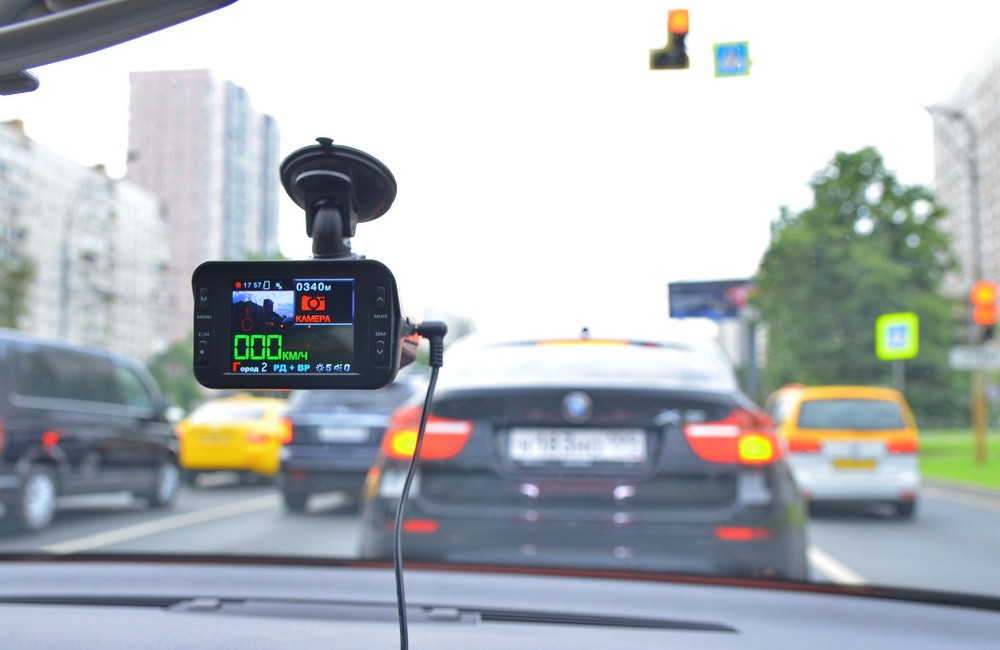
This brand is interesting a few points. Firstly, it is the Russian-Korean brand, domestic experts are directly involved in the development of devices. Secondly, the models of the Inspector model regularly became and become the first on the Russian market in terms of the introduction in the future of “generally accepted” functions of radar detectors and hybrid vehicles. The latter interested me especially, since at the price of models of the order of 10,000 rubles, the Inspector presumably (I will check this in practice) saves at least 5-6 thousand rubles by refusing to buy a separate camera and a “radar finder”. So, first - closely acquainted with the company, and then carefully examine its "Kombik".
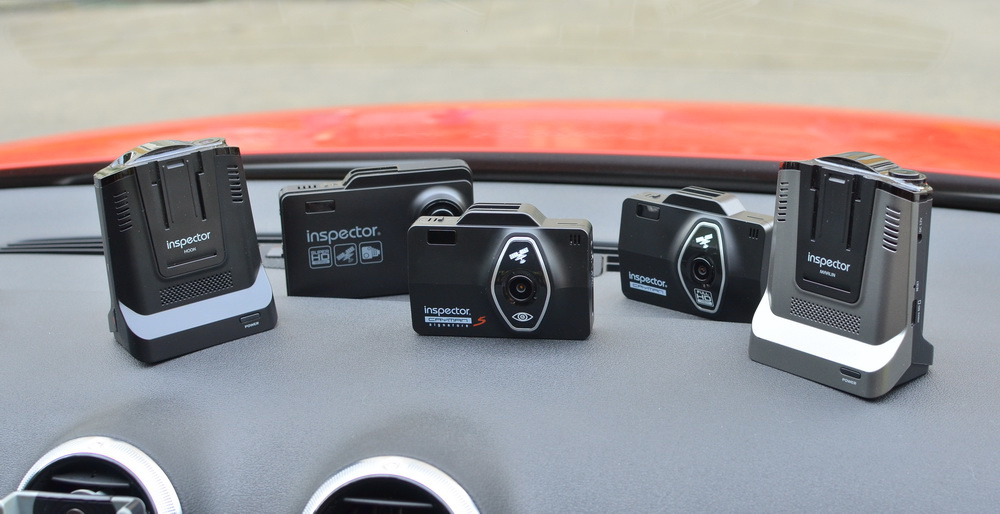 Brand Inspector History
Brand Inspector HistoryInspector is far from new to the automotive electronics market, the brand was founded back in 2000. One of the first devices under the brand Inspector became "solo" radar detectors. However, the vigorous activity of the brand, notable for interesting gadgets, began only in 2010. It is curious that the Inspector immediately chose a clear position - the release of devices of the middle price segment, but with the characteristics, functionality, reliability and usability of devices of a higher level.
In principle, it is quite clear why the Inspector brand took just such a course - in 2010, not many manufacturers of radar detectors were represented on the Russian market. Basically - models of the American brand Escort and the Canadian Whistler, which were estimated in very considerable sums. Inspector set out to offer much more affordable, but not inferior to anything else analogous to American developments.
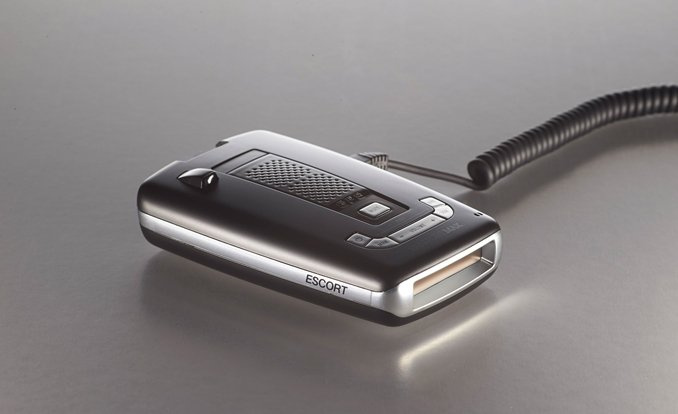
The Inspector does not work according to a typical OEM scheme, when a brand simply orders a ready-made device from Asian partners. And the participation of such a customer is limited only to the choice of place on the gadget where their nameplate will be attached. Well, even if we are talking about a simple DVR, then this approach can be reconciled (just the quality of shooting will be lower than that of competitors with the same characteristics). But if it is a “combo” or a “solo” radar detector, then problems may arise. The fact is that different countries use radars that operate in different frequency ranges. For example, devices of the same American premium brand Escort are sharpened on Ka-band radars, and in Russia they have not been used for quite some time, the majority of our radars operate in the K-band.
Approximately the same story with the "overseas" devices happened with the appearance in our country of the radar complexes "Strelka". Unfortunately, Canadian and American manufacturers were in no hurry to release new models with the ability to "catch" these complexes, and the old ones simply became useless, the benefits of such radar detectors tending to zero.

As for the Inspector brand, things are completely different with it. The brand is Russian-Korean, and domestic engineers are directly involved in the development of devices. Including actively engaged in the adaptation of gadgets for the Russian conditions - the fact that there is no concern to the Americans and Canadians. By the way, on the boxes of the first Inspector models it was even stated that they were specially designed for Russia. This concerned both the radar part and the software in general. By the way, the Inspector was one of the first brands to introduce radar detectors in our country, capable of catching signals from the Strelka-ST complexes, the model was called the Inspector RD X1 Alpha ST.
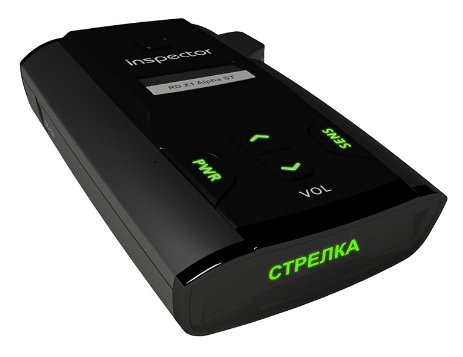
Now everyone is accustomed to the fact that radar detectors and "kombik" do not annoy you with sound signals about approaching the radar, if you do not exceed the speed. Previously, these devices constantly notified about nearby radar complexes (add to this a considerable number of false positives), regardless of how fast you are moving. Many users could not withstand such intrusiveness and turned off the sound, as a result of which they simply missed the alert and ran into fines. Thus, the meaning of the radar detector itself was lost. Now, almost in any such device there is a so-called “speed threshold”, that is, if you do not violate the speed limit, then information about the radars is simply displayed on the screen of the device, without sound alerts.
In principle, today it is a standard, but few people know that it was the Inspector specialists who invented this function and were the first in Russia to implement it. This happened in 2012, and the first model with a “speed threshold” was the Inspector RD X2 Gamma.
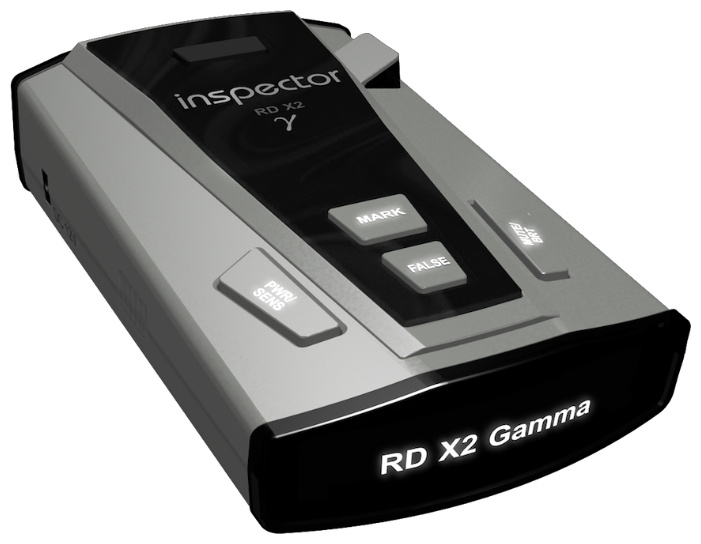
This unit is also notable for the fact that it became the first radar detector on the Russian market with a GPS-receiver and the “speeds” function. For those who do not know what it is about, I will explain. The memory of the gadget contains a base with the coordinates of the stationary and mobile traffic police posts, radar complexes, motion tracking cameras, camera dummies, etc. And thanks to the built-in GPS-module, the device determines the location of the car and checks with the said base. Thus, the Inspector RD X2 Gamma warned in advance about approaching a “dangerous” object. This function also subsequently became standard not only for radar detectors and "kombik", but also for simple DVRs.
In today's realities, after the adoption in Russia of the law banning the use of mobile radar systems in the city, the function of “speedcam” has become particularly useful. So, in the city, you can completely turn off the radar detector and use only the GPS-informant. In Belarus (where I come from) everything is the other way around - in cities, mobile radar systems are used, but on the highways they are stationary.
How do Inspector devices differ from similar devices on the Russian market?Surely among the readers of this material there are skeptics who will not believe in what has been written above and say: they say, there are a lot of devices on the Russian market, like those of the Inspector. And not only with similar characteristics, but even in similar buildings. If you do not go into the question, then we can say that this is so. But judge for yourself. Take, for example, some Samsung smartphone, it will have a whole army of “clones” from nameless and even quite well-known brands (mostly Chinese). They will be similar in appearance and in characteristics. Should I clarify which device will be better? I do not think.
Yes, the characteristics of them are similar (or even the same), but in the same benchmarks Samsung will simply rip their opponents. And business is not limited only to virtual "parrots". It will be noticeably more nimble, it will be better to photograph, it will have a more convenient and pleasant interface and a set of branded useful programs and its own developments.
That's about the same situation with radar detectors, "kombikami" and DVRs. With similar or identical hardware, there may be a different distance when notifying about radar, some radar complexes may not be trapped at all, there may be a large or minimal number of false positives, different video quality (regarding autoregs and combi) and so on. This is why it is especially important not only to assemble certain components on a single board, but also to bring everything to mind (I mean the work of engineers and programmers), as well as to adapt the gadget to a specific market.
Let's take a closer look at the situation with radar detectors and "kombikami", because they are the subject of this material. So, the main component of these devices is the antenna. To date, two types of antennas are used: horn and patch antennas. By and large, they have the same characteristics - they work in the same ranges and at the same distance pick up signals from radar complexes.

The main difference between them is the location of the antenna. In the first case, it is horizontal, so the radar housing detectors and "kombik" with horn antennas are rather bulky, they are extended horizontally. As for the patch antenna, it is located in the case vertically, so the appearance and dimensions of the device are no different from ordinary DVRs.
The second most important component for radar detectors and "kombik" - DSP processor (Digital Signal Processor). It is this one that defines the incoming information as a noise or a radar signal in a specific range. The processor contains signal processing algorithms, and the processing scripts are written by programmers from scratch and individually for each device and for each radar. That is why the software part is so important, the accuracy, the detection range of the radar signal, the number of false positives, etc. depend on the specific DSP firmware. This is exactly what I mentioned above - even if we take devices with the same (or almost the same) characteristics, we will get completely different results.
As for the Inspector brand, it employs five Russian specialists who directly interact with their Korean colleagues, and also check the operation of the devices in the conditions of our country. In addition, the Inspector actively listens to users of its products, of which there are many. This interaction helps to identify the weaknesses of the gadgets and subsequently eliminate them in the new firmware. Special attention is paid to the regions with a large number of various radar complexes and cameras - Moscow, Rostov, Voronezh regions, the Republic of Tatarstan, etc.
In addition to adapting their devices to Russian conditions, the Inspector differs from its competitors in the widest possible functionality and variety of radar settings so that each user can customize everything for themselves. However, this is already clear, considering how many Inspector models have become “unique”, that is, the first of its kind in our country.
 How are things going with the Inspector solo DVRs? Is it China or is it South Korea?
How are things going with the Inspector solo DVRs? Is it China or is it South Korea?As I said above, for DVRs, a competent approach is also very important. Again, we mean the correct layout of parts and software refinement. It is not only the stability and usability that depends on this - it also directly affects the quality of the video.
So where is the development and assembly of autoinspector Inspector? Initially, all the work was done in South Korea. However, due to the economic situation, the assembly had to be transferred to Taiwanese and Chinese factories, where Inspector specialists carry out strict quality control. At the same time, Koreans are still directly involved in the development.
In the field of video recorders, the Inspector also has several significant merits. For example, the Inspector BX-90 model, released in 2011, was one of the first in its class autoregom with a GPS receiver to record the speed and track of a car moving.

It is worth noting that this 100% Korean gadget (developed and assembled in South Korea) wrote a video at a resolution of 640 x 480 pixels. At the same time, the device for several years had plugged the competitors with HD and even Full HD resolution for the belt - again, the result of a competent selection of components and software development by the Inspector specialists. By and large, and today the premium Korean registrar surpasses any competitor in quality of shooting, regardless of the price tag of the latter. It’s just that Koreans have such an approach - to make only high-quality products, and not to “cut the dough in a quick way and whatever happens”, as often happens with Chinese companies.
Another “plus in karma” Inspector - speeds in DVRs. Yes, it was this brand that was the first to suggest using GPS in avtoregi not only for recording speed and track, but also for warning about approaching traffic police posts and speed cameras. Pretty quickly, a contract manufacturer was found, who set about implementing this innovative idea. The rest of the DVR manufacturers could only copy a unique feature from the Inspector.
In the field of combo recorders (DVR and radar detector in one case), the Inspector also managed to make a small revolution. Surely many of you remember the first "kombik" (and, perhaps, some of you and used them). These were quite inconvenient devices with folding screens. Moreover, the latter were used only for the DVR, while the radar detector had its own small display and separate control keys. In general, it was easy to get confused, and without instructions to deal with the management was completely impossible. In 2013, the Inspector corrected the situation by presenting the first in Russia “combo” with the control of a radar detector and a car controller combined in one screen. The model was called Inspector Shark.
 We are testing Korean combo recorders Inspector
We are testing Korean combo recorders InspectorAfter long and very fruitful conversations with a representative of Inspector, it was decided to personally test the “combi” of this brand. I have received five of the most relevant and interesting models:
- Inspector Cayman;
- Inspector Cayman S;
- Inspector Scat;
- Inspector Marlin A7L;
- Inspector Hook.
Before I proceed to the description of the devices, I will say a few words about the principles of the Inspector brand, which are not typical for Russia. This brand offers "kombik" with the widest possible functionality, high quality shooting and effective radar part, but at an affordable price. Judge for yourself, the cost of the Inspector combo recorders is 8-12 thousand rubles, depending on the model. If you look at competitors with similar characteristics, we will see a price tag of 10-15 thousand rubles. In this case, the brand does not inflate the line of devices with similar models, here each device has its own characteristics.
Another positive aspect of the Inspector approach (and also atypical for our country) is the long-term support of its “combiks” - about 3-5 years. By support, I mean the regular release of updates - firmware and databases with the coordinates of radar and posts. Actually, that is why the Inspector for many years has not changed the key Korean factories for itself. Since the change of production capacity means the termination of support firmware. Do you know many examples of such support? I do not think. Even smartphones of well-known brands do not always receive updates for 3-5 years after they go on sale, to say nothing of registrars and combo machines. It is much easier to simply release the model and forget about it, but the Inspector does not look for easy ways, but cares about the users of its devices.
As the brand development director Dmitry Nosakov told me, “we have the desire and the ability to support even the old“ combi ”and radar detectors to the last. These are not empty words, I checked and made sure of this - even for the Inspector X2 Gamma, released back in 2012, there are still updates to the GPS informant base.
It is also worth noting that the brand listens to the opinions of users and implements their suggestions, wishes and comments in new firmware (I already mentioned this above).
Well, let's move on to the tested models of the "combik" Inspector. For clarity, I have compiled a summary table, where I made the main characteristics and features of each considered device.
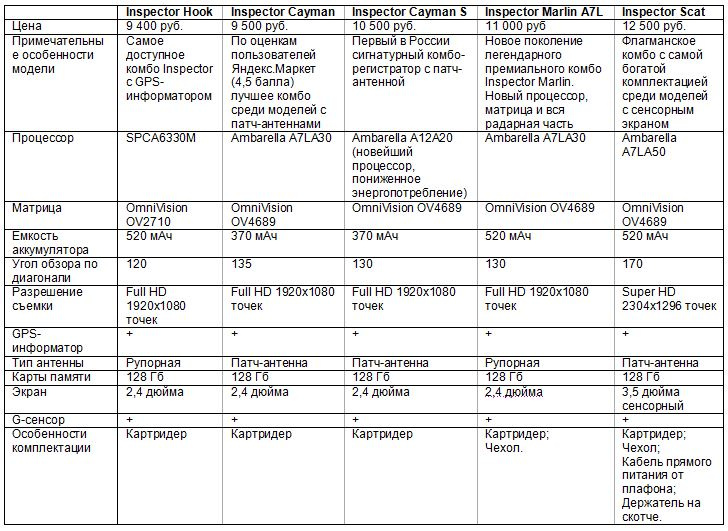
I already wrote about the types of antennas of the radar detector above, so I will not repeat. I will only clarify that the
Inspector Cayman became the first combo-recorder of the brand, which uses a new patch antenna. It was also installed in the flagship Inspector Scat touchscreen model and the
Inspector Cayman S signature signature combo.

The use of an antenna of a new type made it possible to make the devices more compact (in comparison with horn combo recorders).

And what is the "signature" kombik? I will tell about it in a separate section.
Inspector Cayman S and Signature TechnologiesThe signature mode in radar detectors and combo devices is a fairly new function, it appeared only a year ago. The meaning of this technology is to store in the memory of the device signatures ("signatures") radars and speed cameras, and not just notifying that the radar is nearby, but also in indicating its specific model. Such digital "signatures" are created by several parameters of the radiation signal: the frequency of the signal, the number of pulses and the magnitude between them, length, etc. Also, apart from determining the specific radar model, the signature mode allows you to filter out the "extra" radiations in order to negate the number false positives from sensors of automatic doors, walkie-talkies, cruise control of cars and other electronic devices. Thus, the signature-based radar detector or “combo”, in fact, is not inferior to premium-class devices that cost 40-50 thousand rubles. But, unfortunately, this is how it looks only “on paper”; in real life, things are a little different.
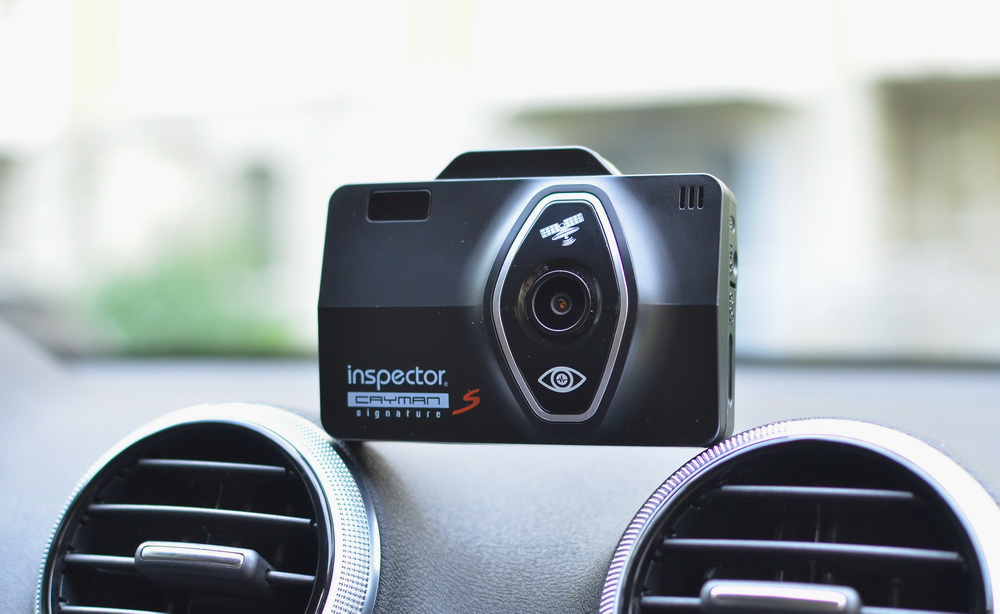
Inspector , «» . Inspector, «» .
Inspector Cayman S , « 100% , 100% ( ) ». - «», . , .
, «» . - , . , ( ) . , – - . , . – , .
, «» . , «» «», «» - ( ) . , , «» «», . - ( ) «», « » – .
Inspector . , «» «». . Inspector , , .

Inspector Cayman S, « IQ», 80 / , . , 80 / , :
- «» ( «-»2);
- «» ( «»);
- «»;
- «»;
- «» (. «»);
- «»;
- «»;
- «»;
- «»;
- «».
80 /, , , , . K-.
Inspector Cayman S. , «» « IQ» . , , Inspector , 100- . , , 99% – . 99%, «» -. , , , - Inspector .
«» Inspector, - Inspector Cayman S , : Cayman, Scat, Marlin A7L Hook. , -, – , . , 600-800 , «» - 1 . , .
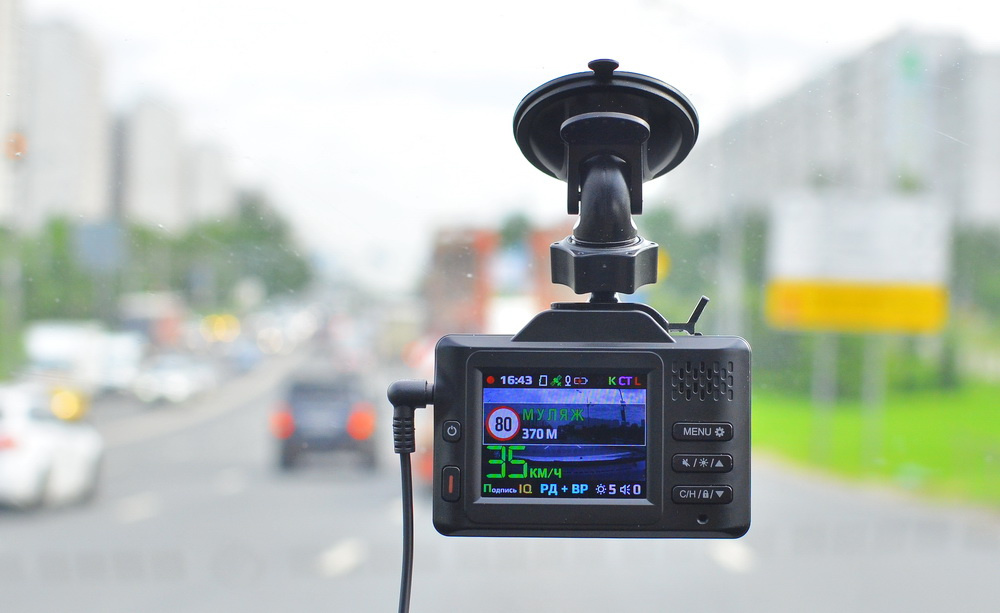
«» Inspector , , - , . «», , « ». , -, GPS-. , . GPS- ().
, - « ». GPS- «» Inspector ( ). , , , . «». , , - .
, , «» Inspector, -. - .
« -, ». , . - - , . . , «» , .


«» Inspector, -. – . , , , . , :

. , «», – , 20 / – , 20 / – . – .

- «» Inspector , . , , «» . , . , «», « » . .
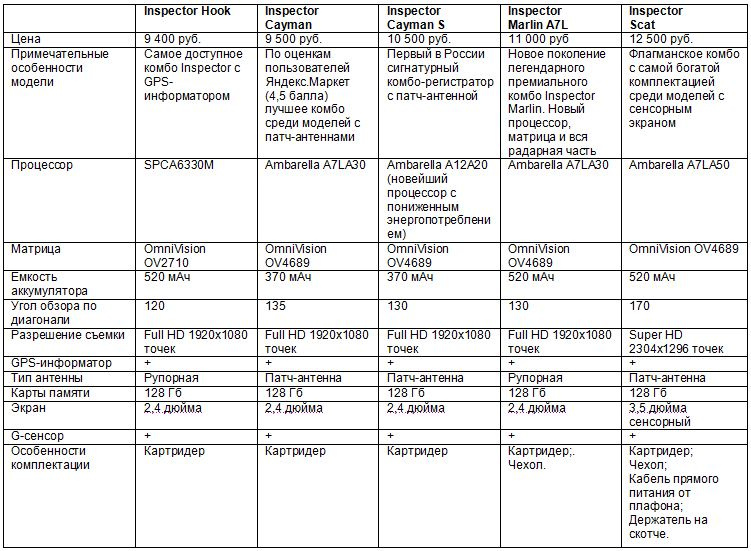
«» –
Inspector Hook 9 400 . – OmniVision OV2710. , Full HD- , , (3 3 ). .
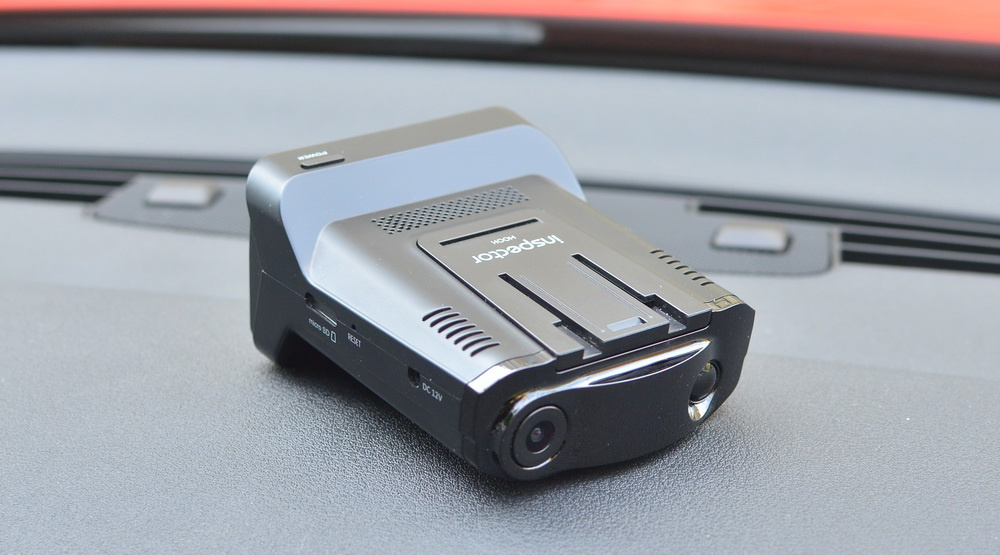
, Inspector Hook «», . , , , . . . 10-12 , , .
Inspector Hook.
Inspector Cayman Inspector Marlin A7L , (Ambarella A7LA30) (OmniVision OV4689). : 135 , – 130 .


, «» . , Inspector Hook , Full HD-. , , «». . 15 , – 10 . , Inspector.
Inspector Cayman:
Inspector Marlin:
, «» 7-10 . Inspector Cayman 9,5 , Inspector Marlin A7L – 11 . , , Inspector -. , 6-7 . «» «» - 17 . - ( , . .), .
Inspector Cayman S . Ambarella A12A20. «» A12, 1920 1080 , Full HD. , Ambarella A7LA30. , -.

Inspector Cayman S «» «» – . , .
Inspector Scat – «» .

OmniVision OV4689 Ambarella A7LA50. Super HD- – 2304 1296 , . , Inspector Cayman, Inspector Marlin A7L Inspector Cayman S.
Conclusion, , Inspector :
1.
Inspector (- 2000 - «»), . – , . , Inspector , «» -.
2. . , Inspector - (3-5 ), GPS-. , -//«». , Inspector «» ( ), .
3. , Inspector – - . «» , . , . .
4. Inspector , . , , – Inspector . , Inspector Scat , Inspector Hook – «» GPS-, Inspector Cayman S – - ..

, , , ! , , - -, schub.alexandr@yandex.ru. !